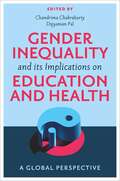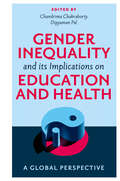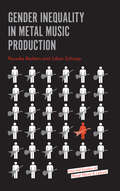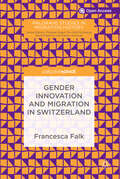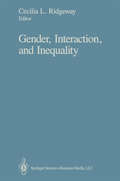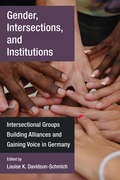- Table View
- List View
Gender Inequalities in the Japanese Workplace and Employment: Theories and Empirical Evidence (Advances in Japanese Business and Economics #22)
by Kazuo YamaguchiThe in-depth analyses presented in this book have a dual focus: (1) Social mechanisms through which the gender wage gap, gender inequality in the attainment of managerial positions, and gender segregation of occupations are generated in Japan; and (2) Assessments of the effects of firms’ gender-egalitarian personnel policies and work–life balance promotion policies on the gender wage gap and the firms’ productivity. In addition, this work reviews and discusses various economic and sociological theories of gender inequality and gender discrimination and considers their consistencies and inconsistencies with the results of the analysis of Japanese data. Furthermore, the book critically reviews and discusses the historical development of the Japanese employment system by juxtaposing rational and cultural explanations. This book is an English translation by the author of a book he first published in Japanese in 2017. The original Japanese-language edition received two major book awards in Japan. One was The Nikkei Economic Book Culture Award, which is given every year by the Nikkei Newspaper Company and the Japan Economic Research Center to a few best books on economy and society. The other was The Showa University’s Women’s Culture Research Award, which is bestowed annually on a single book of research that promotes gender equality. Kazuo Yamaguchi is the Ralph Lewis Professor of Sociology at the University of Chicago.
Gender Inequality: A Reference Handbook (Contemporary World Issues)
by David E. NewtonGender Inequality: A Reference Handbook discusses the role women have played throughout human history and play in the modern day, including both advances that have been made in the fight for equality and problems remaining to be solved.Gender Inequality: A Reference Handbook is divided into two parts. Chapters One and Two provide a historical background to the topic and a review of current issues and problems. The remaining chapters aid readers in continuing their own research on the topic, through an extended annotated bibliography, chronology, glossary, noteworthy individuals and organizations in the field, and important data and documents.This book covers the topic of gender inequality from the earliest pages of human history to the present day. It differs from other works in the field primarily because of the variety of resources provided, such as further reading, perspective essays on the topic, a historical timeline, and useful terms in the field. It is intended for readers of high school through the community college level, along with adult readers who may be interested in the topic.
Gender Inequality: A Reference Handbook (Contemporary World Issues)
by David E. NewtonGender Inequality: A Reference Handbook discusses the role women have played throughout human history and play in the modern day, including both advances that have been made in the fight for equality and problems remaining to be solved.Gender Inequality: A Reference Handbook is divided into two parts. Chapters One and Two provide a historical background to the topic and a review of current issues and problems. The remaining chapters aid readers in continuing their own research on the topic, through an extended annotated bibliography, chronology, glossary, noteworthy individuals and organizations in the field, and important data and documents.This book covers the topic of gender inequality from the earliest pages of human history to the present day. It differs from other works in the field primarily because of the variety of resources provided, such as further reading, perspective essays on the topic, a historical timeline, and useful terms in the field. It is intended for readers of high school through the community college level, along with adult readers who may be interested in the topic.
Gender Inequality and its Implications on Education and Health: A Global Perspective
by Chandrima Chakraborty Dipyaman PalGender inequality has wide-ranging and adverse implications for all of society. For this reason, the United Nations has made it a top priority to address this issue through the Sustainable Development Goals, which state that gender equality is not only a fundamental human right but a necessary foundation for a peaceful, prosperous, and sustainable world. Gender Inequality and its Implications on Education and Health explains the different implications of gender inequality and finds solutions to our most pressing issues. The authors of these collected studies show that though in various contexts around the globe, girls and women are discouraged and prevented from receiving quality education, proper health care, women empowerment and social justice, if this exclusion is eliminated it produces many additional socio-economic gains that benefit entire societies. Focusing largely on India to explore firstly the implications of gender inequality on education and health and then gender inequality and its implications to other SDGs, the chapters extend globally to analyse countries from Asia, Australia, Africa, and Europe. Raising awareness among stakeholders and institutions to recognise the importance of gender inequality throughout the world and its various implications – especially on education and health – Gender Inequality and its Implications on Education and Health provides strategies to achieve gender equality.
Gender Inequality and its Implications on Education and Health: A Global Perspective
by CHANDRIMA CHAKRABORTY, DIPYAMAN PALGender inequality has wide-ranging and adverse implications for all of society. For this reason, the United Nations has made it a top priority to address this issue through the Sustainable Development Goals, which state that gender equality is not only a fundamental human right but a necessary foundation for a peaceful, prosperous, and sustainable world. Gender Inequality and its Implications on Education and Health explains the different implications of gender inequality and finds solutions to our most pressing issues. The authors of these collected studies show that though in various contexts around the globe, girls and women are discouraged and prevented from receiving quality education, proper health care, women empowerment and social justice, if this exclusion is eliminated it produces many additional socio-economic gains that benefit entire societies. Focusing largely on India to explore firstly the implications of gender inequality on education and health and then gender inequality and its implications to other SDGs, the chapters extend globally to analyse countries from Asia, Australia, Africa, and Europe. Raising awareness among stakeholders and institutions to recognise the importance of gender inequality throughout the world and its various implications – especially on education and health – Gender Inequality and its Implications on Education and Health provides strategies to achieve gender equality.
Gender Inequality and Welfare States in Europe
by Mary DalyGender equality has been one of the defining projects of European welfare states. It has proven an elusive goal, not just because of political opposition but also due to a lack of clarity in how to best frame equality and take account of family-related considerations. This wide-ranging book assembles the most pertinent literature and evidence to provide a critical understanding of how contemporary state policies engage with gender inequalities. Examining progress in gender equality in EU member states, this thought-provoking book traces developments from the last decade and earlier regarding women’s and men’s relative positioning in respect of income, employment and time. Located in a critical feminist perspective, the result is a compelling overview of the gender-related achievements in the EU and continuing gaps and inequalities. As well as taking stock of where we are now, the book identifies a research agenda going forward. This seeks to revitalise the feminist social policy project, in light of key welfare state developments and intersectional inequalities in Europe and beyond. This innovative and detailed book constitutes an important contribution to debates about gender equality and policies in Europe and provides a timely reminder of the content of the gender critique of welfare states and why it is still salient.
Gender Inequality in Metal Music Production (Emerald Studies in Metal Music and Culture)
by Pauwke Berkers Julian SchaapFor over four decades, scholars have been investigating male dominance - both symbolically and numerically -within popular music. The heavier genres of popular music, metal music in particular, have been male dominated spaces, which are difficult to navigate for women participating as fans, musicians, or both. Studies on gender inequality in metal music have convincingly demonstrated how gender dynamics shape the reception of metal music and metal scenes all over the globe. Yet, they shed relatively little light on the extent of and reasons for metal music's male domination from a production perspective. This book fills this gap, offering is a systematic and large-scale overview of gender inequality in metal music production. In other words: how many women - compared to men - are participating in metal bands and what are the causes for the differences in participation?
Gender Inequality in Metal Music Production (Emerald Studies in Metal Music and Culture)
by Pauwke Berkers Julian SchaapFor over four decades, scholars have been investigating male dominance - both symbolically and numerically -within popular music. The heavier genres of popular music, metal music in particular, have been male dominated spaces, which are difficult to navigate for women participating as fans, musicians, or both. Studies on gender inequality in metal music have convincingly demonstrated how gender dynamics shape the reception of metal music and metal scenes all over the globe. Yet, they shed relatively little light on the extent of and reasons for metal music's male domination from a production perspective. This book fills this gap, offering is a systematic and large-scale overview of gender inequality in metal music production. In other words: how many women - compared to men - are participating in metal bands and what are the causes for the differences in participation?
Gender Inequality in Screenwriting Work
by Natalie WreyfordThis is the first book to critically examine the recruitment and working practices of screenwriters. Drawing on interviews with screenwriters and those that employ them, Natalie Wreyford provides a deep and detailed understanding of entrenched gender inequality in the UK film industry and answers the question: what is preventing women from working as screenwriters? She considers how socialised recruitment and gendered taste result in exclusion, and uncovers subtle forms of sexism that cause women’s stories and voices to be discounted. Gender Inequality in Screenwriting Work also reveals the hidden labour market of the UK film industry, built on personal connections, homophily and the myth of meritocracy. It is essential reading for students and scholars of gender, creative industries, film and cultural studies, as well as anyone who wants to understand why women remain excluded from many key roles in filmmaking.
Gender Inequality in the Eastern European Labour Market: Twenty-five years of transition since the fall of communism (Routledge Contemporary Russia and Eastern Europe Series)
by Giovanni RazzuUnder communism there was, in the countries of Eastern Europe, a high level of gender equality in the labour market, particularly in terms of high participation rates by women. The transition from communism has upset this situation, with different impacts in the different countries. This book presents a comprehensive overview of gender and the labour market since the fall of communism in a wide range of Eastern European countries. Each country chapter describes the nature of inequality in the particular country, and goes on to examine the factors responsible for this, including government policies, changing social attitudes, levels of educational attainment and the impact of motherhood. Overall, the book provides an interesting comparison to the situation in Western developed countries, outlining differences and similarities. No one single Eastern European model emerges while, as in Western developed countries, a range of experiences and trends is the norm.
Gender Inequality in the Eastern European Labour Market: Twenty-five years of transition since the fall of communism (Routledge Contemporary Russia and Eastern Europe Series)
by Giovanni RazzuUnder communism there was, in the countries of Eastern Europe, a high level of gender equality in the labour market, particularly in terms of high participation rates by women. The transition from communism has upset this situation, with different impacts in the different countries. This book presents a comprehensive overview of gender and the labour market since the fall of communism in a wide range of Eastern European countries. Each country chapter describes the nature of inequality in the particular country, and goes on to examine the factors responsible for this, including government policies, changing social attitudes, levels of educational attainment and the impact of motherhood. Overall, the book provides an interesting comparison to the situation in Western developed countries, outlining differences and similarities. No one single Eastern European model emerges while, as in Western developed countries, a range of experiences and trends is the norm.
Gender Inequality in the Ordained Ministry of the Church of England: Examining Conservative Male Clergy Responses to Women Priests and Bishops (Routledge Studies in Religion)
by Alex D.J. FryThis book offers a fresh social scientific analysis of how theologically conservative male clergy respond to the ordination of women to the priesthood and their consecration as bishops within the Church of England. The question of women’s place in the formal structures of England’s Established Church remains contested. For many, to prevent women from occupying such offices is often understood to be a matter of inequality, whereas those who oppose their ordination see it as a matter of obedience to God’s will. Tensions have become heightened in a culture that increasingly promotes the rights of individuals who have historically been marginalised and that challenges traditional social roles. This volume explores the gender attitudes held by clergy in the Anglo-Catholic and evangelical traditions of the Church and considers how these gender attitudes shape the way they think about women’s ordination and how they interact with female colleagues. It also considers the contribution of a range of social phenomena to the formation of these gender attitudes. The author draws on and develops a variety of sociological and psychological theories that help to explain the processes that lead to the formation of clergy attitudes towards gender more broadly.
Gender Inequality in the Ordained Ministry of the Church of England: Examining Conservative Male Clergy Responses to Women Priests and Bishops (Routledge Studies in Religion)
by Alex D.J. FryThis book offers a fresh social scientific analysis of how theologically conservative male clergy respond to the ordination of women to the priesthood and their consecration as bishops within the Church of England. The question of women’s place in the formal structures of England’s Established Church remains contested. For many, to prevent women from occupying such offices is often understood to be a matter of inequality, whereas those who oppose their ordination see it as a matter of obedience to God’s will. Tensions have become heightened in a culture that increasingly promotes the rights of individuals who have historically been marginalised and that challenges traditional social roles. This volume explores the gender attitudes held by clergy in the Anglo-Catholic and evangelical traditions of the Church and considers how these gender attitudes shape the way they think about women’s ordination and how they interact with female colleagues. It also considers the contribution of a range of social phenomena to the formation of these gender attitudes. The author draws on and develops a variety of sociological and psychological theories that help to explain the processes that lead to the formation of clergy attitudes towards gender more broadly.
Gender Inequality in the Public Sector in Pakistan: Representation and Distribution of Resources
by K. ChauhanAs gender training is applied increasingly as a development solution to gender inequality, this book examines gender inequality in Pakistan's public sector and questions whether a singular focus on gender training is enough to achieve progress in a patriarchal institutional context.
Gender, Informal Institutions and Political Recruitment: Explaining Male Dominance in Parliamentary Representation (Gender and Politics)
by E. BjarnegårdParliaments around the world are still overwhelmingly populated by men, yet studies of male dominance are much rarer than are studies of female under-representation. In this book, men in politics are the subjects of a gendered analysis. How do men manage to hold on to positions of power despite societal trends in the opposite direction? And why do men seek to cooperate mainly with other men? Elin Bjarnegård studies how male networks are maintained and expanded and seeks to improve our understanding of the rationale underlying male dominance in politics. The findings build on results both from statistical analyses of parliamentary composition worldwide and from extensive field work in Thailand. A new concept, homosocial capital, is coined and developed to help us understand the persistence of male political dominance.
Gender Innovation and Migration in Switzerland (Palgrave Studies in Migration History)
by Francesca FalkThis open access book analyses migration and its relation to socio-political transformation in Switzerland. It addresses how migration has made new forms of life possible and shows how this process generated gender innovation in different fields: the changing division of work, the establishment of a nursery infrastructure, access to higher education for women, and the struggle for female suffrage. Seeing society through the lens of migration alters the perspective from which our past and thus our present is told—and our future imagined.
Gender Innovation in Political Science: New Norms, New Knowledge (Gender and Politics)
by Marian Sawer Kerryn BakerIn this book, leading gender scholars survey the contribution of feminist scholarship to new norms and knowledge in diverse areas of political science and related political practice. They provide new evidence of the breadth of this contribution and its policy impact. Rather than offering another account of the problem of gender inequality in the discipline, the book focuses on the positive contribution of gender innovation. It highlights in a systematic and in-depth way how gender innovation has contributed to sharpening the conceptual tools available in different subfields, including international relations and public policy. At the same time, the authors show the limits of impact in core areas of an increasingly pluralised discipline. This volume will appeal to scholars and students of political science and international relations.
Gender, Institutions, and Change in Bachelet’s Chile (Studies of the Americas)
by G. WaylenMichele Bachelet, Chile's first female president, was elected with an explicit gender agenda in 2006 and then reelected in 2013. This volume focuses on Bachelet's efforts to introduce progressive measures and the constraints that she has faced in a context where both formal and informal political institutions can act as barriers to change.
Gender Integration in NATO Military Forces: Cross-national Analysis (Gender in a Global/Local World)
by Lana ObradovicNumerous states have passed gender integration legislation permanently admitting women into their military forces. As a result, states have dramatically increased women’s numbers, and improved gender equality by removing a number of restrictions. Yet despite changes and initiatives on both domestic and international levels to integrate gender perspectives into the military, not all states have improved to the same extent. Some have successfully promoted gender integration in the ranks by erasing all forms of discrimination, but others continue to impede it by setting limitations on equal access to careers, combat, and ranks. Why do states abandon their policies of exclusion and promote gender integration in a way that women’s military participation becomes an integral part of military force? By examining twenty-four NATO member states, this book argues that civilian policymakers and military leadership no longer surrender to parochial gendered division of the roles, but rather support integration to meet the recruitment numbers due to military modernization, professionalization and technological advancements. Moreover, it proposes that increased pressure by the United Nations to integrate gender into security and NATO seeking standardization and consistency on the international level, and women’s movements on the domestic level, are contributing to greater gender integration in the military.
Gender Integration in NATO Military Forces: Cross-national Analysis (Gender in a Global/Local World)
by Lana ObradovicNumerous states have passed gender integration legislation permanently admitting women into their military forces. As a result, states have dramatically increased women’s numbers, and improved gender equality by removing a number of restrictions. Yet despite changes and initiatives on both domestic and international levels to integrate gender perspectives into the military, not all states have improved to the same extent. Some have successfully promoted gender integration in the ranks by erasing all forms of discrimination, but others continue to impede it by setting limitations on equal access to careers, combat, and ranks. Why do states abandon their policies of exclusion and promote gender integration in a way that women’s military participation becomes an integral part of military force? By examining twenty-four NATO member states, this book argues that civilian policymakers and military leadership no longer surrender to parochial gendered division of the roles, but rather support integration to meet the recruitment numbers due to military modernization, professionalization and technological advancements. Moreover, it proposes that increased pressure by the United Nations to integrate gender into security and NATO seeking standardization and consistency on the international level, and women’s movements on the domestic level, are contributing to greater gender integration in the military.
Gender, Interaction, and Inequality
by Cecilia L. RidgewayCausal explanations are essential for theory building. In focusing on causal mechanisms rather than descriptive effects, the goal of this volume is to increase our theoretical understanding of the way gender operates in interaction. Theoretical analyses of gender's effects in interaction, in turn, are necessary to understand how such effects might be implicated with individual-level and social structural-level processes in the larger system of gender inequality. Despite other differences, the contributors to this book all take what might be loosely called a "microstructural" approach to gender and interaction. All agree that individuals come to interaction with certain common, socially created beliefs, cultural meanings, experiences, and social rules. These include stereotypes about gendered activities and skills, beliefs about the status value of gender, rules for interacting in certain settings, and so on. However, as individuals apply these beliefs and rules to the specific contingent events of interaction, they combine and reshape their implications in distinctive ways that are particular to the encounter. As a result, individuals actively construct their social relations in the encounter through their interaction. The patterns of relations that develop are not completely determined or scripted in advance by the beliefs and rules of the larger society. Consequently, there is a reciprocal causal relationship between constructed patterns of interaction and larger social structural forms. The constructed patterns of social relations among a set of interactants can be thought of as micro-level social structures or, more simply, "microstructures.
Gender, Internet Use, and Covid-19 in the Global South: Multiple Causalities and Policy Options (SpringerBriefs in Economics)
by Jeffrey JamesThis book analyzes the use of the mobile Internet against the background of gender bias and Covid-19, currently two of the most important and pressing problems of the Global South. The book argues that the degree of benefits from this new technology depends heavily on the way it is actually used and that most new technologies are developed for the conditions prevailing in rich countries, where they tend to be quite easily adopted and used. In the Global South, by contrast, a paucity of digital skills and other factors make the potentially valuable benefits from the Internet much more difficult to derive. Using empirical data recently provided by the Groupe Speciale Mobile Association (GSMA), the book examines the existence and extent of the digital divide between males and females in mobile Internet use, which constitutes a new form of divide. It sheds light on the acute difficulty for first-time mobile Internet users in the Global South, and especially Sub-Saharan Africa, to learn the digital skills that are needed to use the said technology effectively, with a special focus on how these users acquire the required knowledge, without having undergone the process of learning by doing. The book further discusses the determinants of digital skills in the Global South, as well as major factors underlying the extent to which different users actually benefit from the mobile Internet, such as gender, location, age, and education. Finally, it investigates how womens' use of the Internet has been altered by the pandemic in the Global South.This book will appeal to students, researchers, and scholars of development economics and development studies, as well as policy-makers interested in a better understanding of the impact of gender bias and Covid-19 on mobile internet use in the Global South.
Gender, Intersectionality and Climate Institutions in Industrialised States (Routledge Studies in Gender and Environments)
by Gunnhildur Lily Magnusdottir and Annica KronsellThis book explores how climate institutions in industrialized countries work to further the recognition of social differences and integrate this understanding in climate policy making. With contributions from a range of expert scholars in the field, this volume investigates policy-making in climate institutions from the perspective of power as it relates to gender. It also considers other intersecting social factors at different levels of governance, from the global to the local level and extending into climate-relevant sectors. The authors argue that a focus on climate institutions is important since they not only develop strategies and policies, they also (re)produce power relations, promote specific norms and values, and distribute resources. The chapters throughout draw on examples from various institutions including national ministries, transport and waste management authorities, and local authorities, as well as the European Union and the UNFCCC regime. Overall, this book demonstrates how feminist institutionalist theory and intersectionality approaches can contribute to an increased understanding of power relations and social differences in climate policy-making and in climate-relevant sectors in industrialized states. In doing so, it highlights the challenges of path dependencies, but also reveals opportunities for advancing gender equality, equity, and social justice. Gender, Intersectionality and Climate Institutions in Industrialized States will be of great interest to students and scholars of climate politics, international relations, gender studies and policy studies.
Gender, Intersectionality and Climate Institutions in Industrialised States (Routledge Studies in Gender and Environments)
by Gunnhildur Lily Magnusdottir Annica KronsellThis book explores how climate institutions in industrialized countries work to further the recognition of social differences and integrate this understanding in climate policy making. With contributions from a range of expert scholars in the field, this volume investigates policy-making in climate institutions from the perspective of power as it relates to gender. It also considers other intersecting social factors at different levels of governance, from the global to the local level and extending into climate-relevant sectors. The authors argue that a focus on climate institutions is important since they not only develop strategies and policies, they also (re)produce power relations, promote specific norms and values, and distribute resources. The chapters throughout draw on examples from various institutions including national ministries, transport and waste management authorities, and local authorities, as well as the European Union and the UNFCCC regime. Overall, this book demonstrates how feminist institutionalist theory and intersectionality approaches can contribute to an increased understanding of power relations and social differences in climate policy-making and in climate-relevant sectors in industrialized states. In doing so, it highlights the challenges of path dependencies, but also reveals opportunities for advancing gender equality, equity, and social justice. Gender, Intersectionality and Climate Institutions in Industrialized States will be of great interest to students and scholars of climate politics, international relations, gender studies and policy studies.
Gender, Intersections, and Institutions: Intersectional Groups Building Alliances and Gaining Voice in Germany
by Louise K Davidson-SchmichGermany serves as a case study of when and how members of intersectional groups—individuals belonging to two or more disadvantaged social categories—capture the attention of policymakers, and what happens when they do. This edited volume identifies three venues through which intersectional groups are able to form alliances and generate policy discussions regarding their concerns. Original empirical case studies focus on a wide range of timely subjects, including the intersexed, gender and disability rights, lesbian parenting, women working in STEM fields, workers’ rights in feminized sectors, women in combat, and Muslim women and girls.



